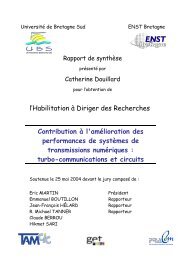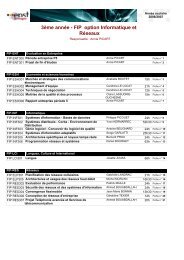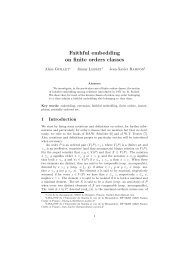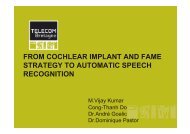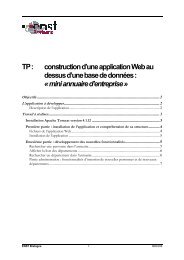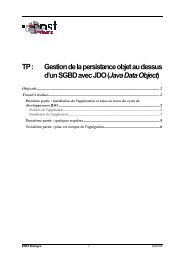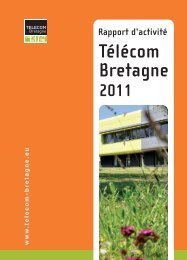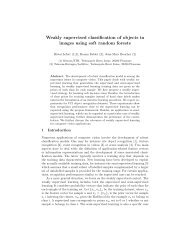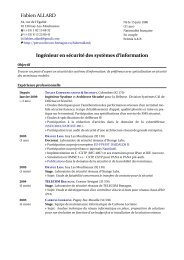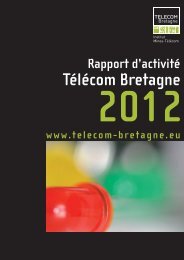researResearch - Télécom Bretagne
researResearch - Télécom Bretagne
researResearch - Télécom Bretagne
You also want an ePaper? Increase the reach of your titles
YUMPU automatically turns print PDFs into web optimized ePapers that Google loves.
h Research<br />
9<br />
RESEARCH<br />
Main achievements of the project<br />
1) The A3000 project aims to construct a<br />
pictogram dictionary representing the writing of<br />
words in the French language that are useful in<br />
the construction of actual texts; pictograms<br />
(lexical or grammatical) that represent changes<br />
are understood better if they are animated. This<br />
project brings together the following entities: the<br />
small-to-midsized business R/D/I+, who are<br />
specialists in Implementation and Development in<br />
Computer Science (project leader); Telecom<br />
<strong>Bretagne</strong> (linguistic expertise); the company<br />
Hippocampe (graphics), located in Brest; the Saint<br />
Maurice hospital; and the halfway house in<br />
Ploudaniel. The project is financially supported by<br />
the French Ministry of Research in the program<br />
entitled "Usage des NTIC" (Uses of NICT). A<br />
second version of the Axelia product, marketed by<br />
RDI+, is currently being evaluated by the Saint<br />
Maurice hospital. We undertook a collaboration<br />
with UBO (University of Western Brittany)<br />
professors involved in the Masters program<br />
"Social Action and Health", concerning uses of the<br />
product by speech-challenged clients and their<br />
"mediators".<br />
2) "Textopicto: from text to pictogram" is intended<br />
for a family wishing to write a normal message or<br />
an e-mail to a person who does not know how to<br />
read and who doesn't have access to voice<br />
synthesis. In order for the recipient to be able to<br />
decipher it, it must first be translated into lexical<br />
pictograms, encapsulated in grammatical<br />
pictograms. A model was tested with examples of<br />
children's letters, through a CRITT-Health<br />
contract. The goal is now to develop this program<br />
with respect to linguistics and the ergonomics of<br />
the interfaces, in order to make it more direct and<br />
more precise in reading the messages: the lexical<br />
pictograms are salient, and grammatical<br />
attributes are a sort of reading key for the<br />
understanding of the semantic role of the words<br />
involved.<br />
PALLIACOM aims to develop a communicator<br />
capable of allowing people who do not have access<br />
to ordinary communicative functions (speech and<br />
gestures making writing possible) to produce text.<br />
PALLIACOM brings together in a single<br />
communicator several writing options<br />
(alphabetical, logographic, or mixed), making<br />
possible the assisted production of text whose<br />
words are controlled by the writer, through virtual<br />
configurable keyboards, set up according to the<br />
gestual, perceptual and cognitive possibilities of<br />
the user.<br />
The scientific challenges concern several<br />
disciplines, which will have to determine how to<br />
produce text when writing is indirect, assisted, or<br />
based on reading characters or logograms<br />
instead of the alphabet.<br />
Spin-offs of the project aim for fundamental<br />
advancements of the subjacent linguistic and<br />
neuropsycholinguistic models, and more<br />
particularly to make available a configurable,<br />
adapted multimodal communicator intended for<br />
users to take into consideration in their life plans.<br />
4) We have begun projects supported by the region<br />
intended to test and validate communicator uses<br />
in the various cases in question. Along this line,<br />
the ACADIAL project, with the IME 3 of Rennes, and<br />
supported by the region of Brittany (ASOSC),<br />
submitted in June of 2008, began in early 2009.<br />
5) A thesis in ethnology (co-directed with the UEB 4 )<br />
on memory, supported by the Médéric Alzheimer<br />
foundation, was begun in October.<br />
3) ANR TECSAN contract: A project proposal was<br />
accepted with the IRIT 2 of Toulouse and the smallto-midsized<br />
business R/D/I+: PALLIACOM (project<br />
leader : Maryvonne Abraham)<br />
2) IRIT : Institut de recherche en informatique de Toulouse (Institute of Computer Science Research of<br />
Toulouse)<br />
3) IME : Institut médico-éducatif (Medical educational institute)<br />
4) UEB : Université européenne de <strong>Bretagne</strong> (European University of Brittany)<br />
113



